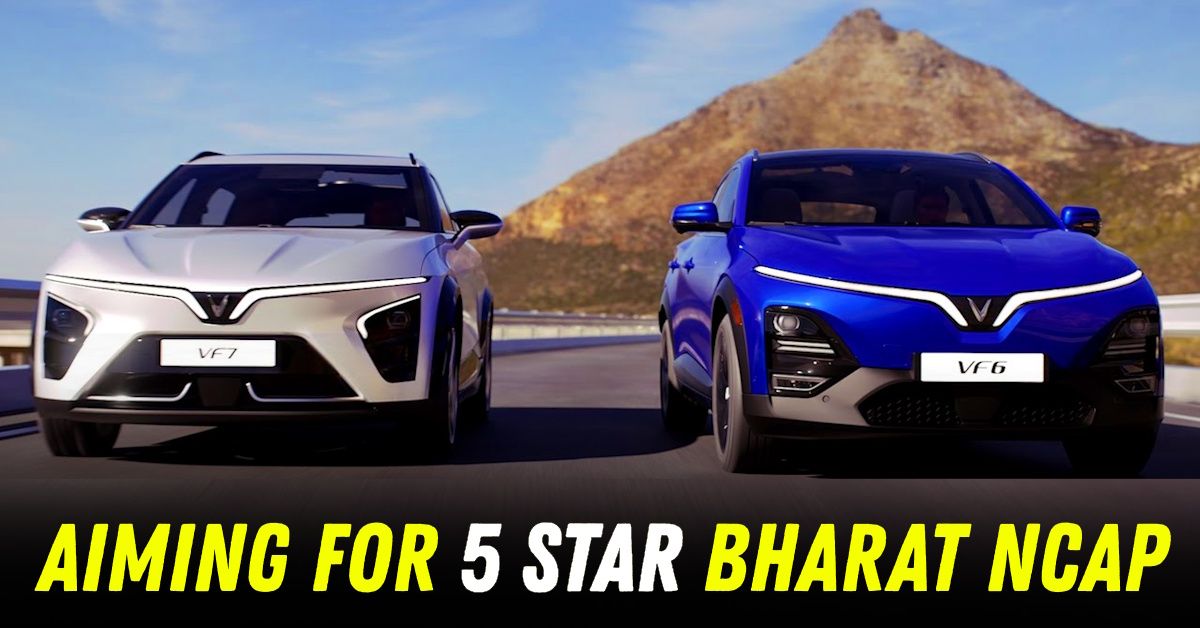VinFast Targets 5-Star Bharat NCAP Rating For VF6 And VF7 Electric SUVs


VinFast, the Vietnamese electric vehicle manufacturer preparing to enter the market, isn’t just promising competitive products. It’s targeting nothing less than perfect five-star Bharat NCAP ratings for both its debut models, the VF6 and VF7. But in a landscape where safety credentials can make or break a brand’s reputation, the question looms large: is this ambitious target realistic, or merely marketing bravado?
VinFast faces a unique challenge as it prepares for its market debut later this year. Unlike established manufacturers who have built their reputations over decades, this Vietnamese newcomer must prove itself from day one. The company’s strategy reveals a deep understanding of priorities. Safety has become a non-negotiable factor for buyers, especially in the premium electric vehicle segment where VinFast plans to compete.
The numbers tell a compelling story. Both the VF6 and VF7 will come equipped with seven airbags as standard, significantly exceeding the minimum requirements for top-tier safety ratings. Additionally, Level 2 Advanced Driver Assistance Systems (ADAS) will be standard across both models, featuring technologies that can prevent accidents before they occur. These aren’t afterthoughts or optional extras. They’re fundamental to VinFast’s value proposition.
What makes VinFast’s safety claims particularly interesting is the company’s approach to market preparation. Rather than simply importing existing models, VinFast has undertaken substantial engineering modifications specifically for local conditions. The ground clearance has been raised to 190mm, and both vehicles feature reinforced chassis structures designed to meet Bharat NCAP’s rigorous testing protocols.
The testing itself is no gentle affair. Bharat NCAP evaluates vehicles through front impact tests at 64 kilometres per hour, side impact tests at 50 kilometres per hour, and side pole impact tests at 29 kilometres per hour. Each test uses sophisticated crash test dummies equipped with sensors that measure the forces experienced during impact. To achieve five stars, vehicles must score at least 27 out of 32 points for adult protection and 41 out of 49 points for child protection.
Here’s where the story becomes more nuanced. Since Bharat NCAP’s launch in October 2023, the majority of tested vehicles have indeed achieved five-star ratings. Models from Tata, Mahindra, and others have consistently scored well, suggesting that achieving top marks isn’t impossible. But it’s not guaranteed either.
However, VinFast’s confidence stems from more than engineering specifications. The company has experience in other markets where safety standards are equally demanding. The VF6 and VF7 weren’t designed in isolation. They’re part of a global platform that has already undergone extensive safety validation in international markets.
VinFast’s safety focus reflects a broader transformation in automotive priorities. Road accidents claim approximately 150,000 lives annually across the country, making vehicle safety a critical public policy concern. The government has set an ambitious target to reduce road accident fatalities by over 50 percent. Programmes like Bharat NCAP are central to achieving this goal.
For consumers, this focus on safety represents excellent news. The days when safety features were luxury additions are rapidly ending. VinFast’s commitment to standard seven airbags and comprehensive ADAS across both models signals a new baseline for what buyers should expect.
But safety isn’t just about crash test performance. Real-world safety depends on factors like build quality, component reliability, and service support. Areas where VinFast remains largely untested. The company’s local assembly facility in Tamil Nadu will begin operations in July 2025, but the true test will come when vehicles start accumulating real-world mileage.
The integration of safety technologies also matters enormously. Having seven airbags means little if the sensors that deploy them aren’t calibrated correctly. ADAS systems require ongoing updates and maintenance to function effectively. VinFast’s ability to support these complex systems through its nascent service network will ultimately determine whether its safety promises translate into real-world protection.
VinFast’s five-star Bharat NCAP ambition might be achievable based on the specifications and engineering modifications made for local conditions. The company’s comprehensive approach, combining structural integrity, passive safety features, and active safety technologies, suggests a serious commitment to occupant protection.
However, true safety extends beyond laboratory conditions. VinFast’s ultimate success will depend not just on achieving impressive test scores, but on maintaining that safety performance throughout the ownership experience. For buyers considering these Vietnamese EVs, the safety ratings will certainly be encouraging. But they should be just the beginning of the evaluation process, not the end.